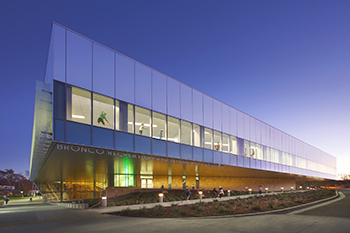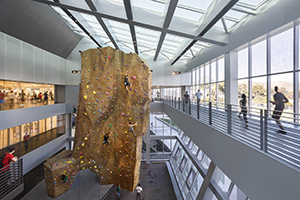Q&A: Cal Poly Pomona Opens Safe & Secure Rec Center
 POMONA, Calif. — Cal Poly Pomona celebrated its new Bronco Recreation and Intramural Center (BRIC) late last year. Designed by Irvine, Calif.-based LPA Inc., the 120,000-square-foot, three-story recreation center has quickly become a central hub for student activity on the Cal Poly Pomona campus. In fact, the school reported that the recreation center encourages students to remain on campus longer, meet and mingle with peers, and relieve stress in a healthy way.
POMONA, Calif. — Cal Poly Pomona celebrated its new Bronco Recreation and Intramural Center (BRIC) late last year. Designed by Irvine, Calif.-based LPA Inc., the 120,000-square-foot, three-story recreation center has quickly become a central hub for student activity on the Cal Poly Pomona campus. In fact, the school reported that the recreation center encourages students to remain on campus longer, meet and mingle with peers, and relieve stress in a healthy way.
School Construction News spoke with Ozzie Tapia, AIA, LEED AP BD+C, project designer at LPA Inc., about how the design team created a safe and secure facility while maintaining the open and interactive feel typical of recreation centers.
Q: What was the main goal of the project?
Tapia: As the last critical piece to the campus life and activity puzzle, the main goal of the BRIC was to provide a true hub of student life on campus — an exciting and lively destination to see and be seen, where students can exercise, hang out and relax while immersed in a sustainable environment. The program includes a three-court gymnasium, a multi-activity court (MAC), rock climbing wall, weight and fitness areas, several multipurpose rooms, racquetball courts, an indoor running track and a 6,500-square-foot outdoor pool.
Q: What are some of the project’s key design elements?
Tapia: Neighboring sports facilities on campus were notorious for their lack of connection to the exterior, so a shift away from this paradigm of introverted buildings was established. The BRIC frames and makes a direct connection to the adjacent campus quad and views beyond by opening up to them visually with a façade primarily composed of glass, and physically by breaking the building open at the intersection of major pedestrian paths converging at the building’s entry.
This augmented transparency allows the recreation center to become a human billboard of student activity. At its center, the mixed-mode, naturally ventilated atrium houses a 55-foot-high, rock climbing wall. It acts as a transitional space between the true exterior and conditioned interior spaces.
Q: What safety or security measures were incorporated into the design?
 Tapia: The building and pool enclosures were designed as one secured compound. While all code-required emergency exits are in place, there’s essentially one entry and exit point through the three-story atrium main entry. Turnstiles with handprint-scanning technology streamline user access and oversight. Furthermore, the interiors were designed as a series of large open volumes that are visually connected, reducing hidden corners and spaces. This allows for maximum supervision with minimal staff.
Tapia: The building and pool enclosures were designed as one secured compound. While all code-required emergency exits are in place, there’s essentially one entry and exit point through the three-story atrium main entry. Turnstiles with handprint-scanning technology streamline user access and oversight. Furthermore, the interiors were designed as a series of large open volumes that are visually connected, reducing hidden corners and spaces. This allows for maximum supervision with minimal staff.
In high activity areas such as recreational courts and the rock climbing wall, materials were carefully selected in and around safety and run-off zones to support the wellbeing of users and — at the same time — not detract from the experience.
Q: Was staff and student feedback provided to the design team?
Tapia: The BRIC was funded entirely by student fees, and this allowed for a unique, more inclusive process from the beginning. A series of open-forum design charrettes were carried out with students and staff on campus. We received direct feedback on everything from actual program and amenities prioritization to building system and materials selection to the simple fact that a truly sustainable facility that mirrored their values was very important to the student body.
Q: What were some of the project’s key challenges, and how did your team overcome those challenges?
Tapia: A key challenge from the get-go was to accommodate a large program on an awkwardly shaped site — bound by easements, setbacks and challenging topography — with less than optimal orientation. The design solution was to use these site limitations as driving forces to actually shape the building by maximizing the footprint, extruding up and expanding horizontally once above the constraints. However, once it became clear that the upper floor needed to be much larger than the ground level, LPA’s in-house engineers and architects designed and implemented a unique Vierendeel truss structural system to support the large cantilevers, while avoiding the exterior columns that the university expressed it did not want.
